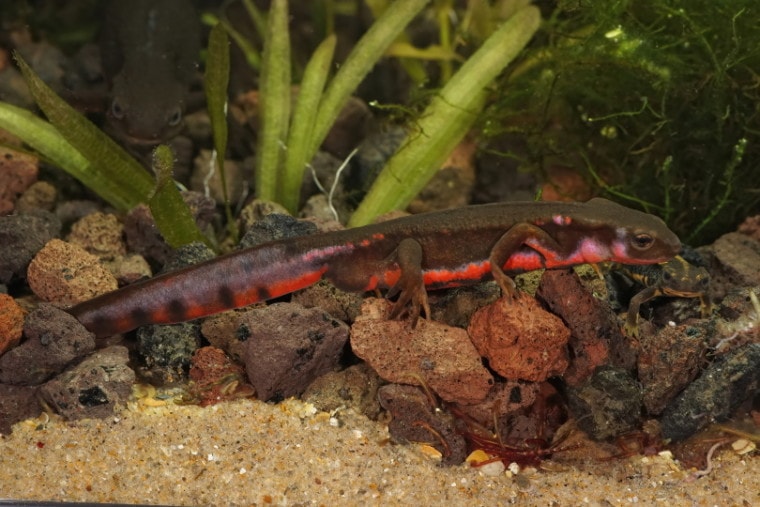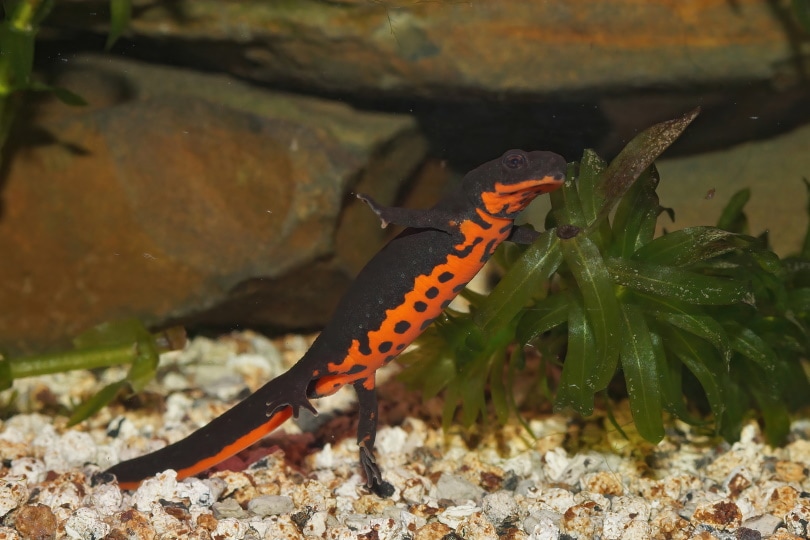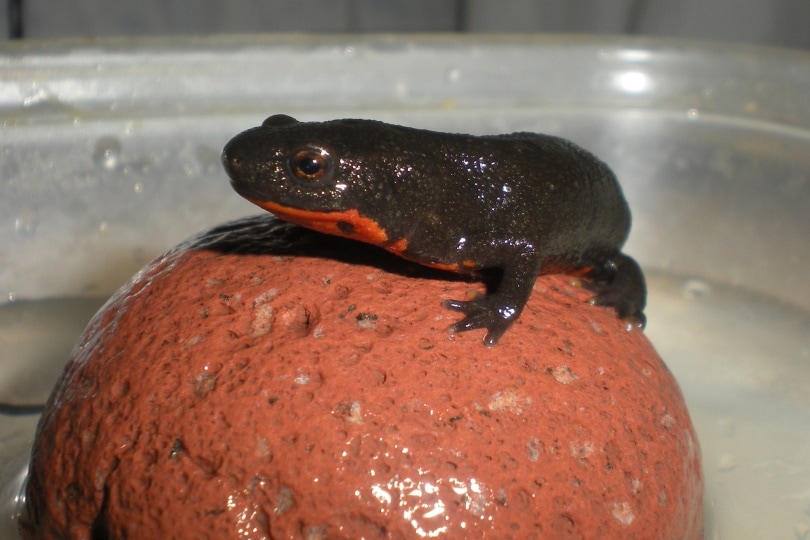
Fire belly newts are among the most common exotic amphibians available in pet stores. Hardy and relatively easy to care for, they are a popular choice and a good option for the novice amphibian keeper.
However, any reptile or amphibian requires more specific care than small domestic mammals such as hamsters or mice. In this guide, you will discover the basic tips for taking care of these fascinating Urodeles.
 Quick Facts about Fire Belly Newt
Quick Facts about Fire Belly Newt
| Species Name | Cynops orientalis, Cynops pyrrhogaster |
| Family | Salamandridae |
| Care Level | Beginner/easy |
| Temperature | 62°F to 68°F |
| Temperament | Nocturnal, active, hardy, easy to care for |
| Color Form | Back: dark brown, black Belly: bright yellow or scarlet red with scattered black spots |
| Lifespan | 10 to 15 years on average and up to 30 years |
| Size | 3 to 6 inches |
| Diet | Carnivore |
| Minimum Tank Size | 10 gallons |
| Tank Set-Up | 70% water and 30% land (e.g., gravel), aquatic plants |
| Compatibility | Not territorial or aggressive, can coexist with other newts of the same species |
Fire Belly Newt Overview
The name “fire belly newt” refers to various aquatic species of salamander, which have become popular as pets in recent years. This is in part due to the ease of their care compared to other exotic amphibians. The Chinese fire belly newt (Cynops orientalis) is the most popular but can be confused with the Japanese fire belly newt (Cynops pyrrhogaster) due to its similarities in colors and size.
However, you should know that although these two different species can be sold as pets, the Japanese newt excretes a toxin through its skin (tetrodotoxin) which can be potentially fatal for humans and animals if ingested. The good news is that it tends to lose its high toxicity when bred in captivity.
Careful, though, because that doesn’t mean their toxin becomes harmless!
In fact, both species excrete this toxin, but the Chinese newt is only mildly poisonous. This means that you need to be extremely careful when handling your newt, as even the mild version of the toxin can cause skin irritation or numbness.
That said, you can still enjoy their exotic beauty in an aquarium tailored specifically to their needs for many years to come, as they have an impressive lifespan of up to 30 years.

How Much Do Fire Belly Newt Cost?
You won’t have to smash your piggy bank to buy a fire belly newt. Indeed, you can expect to pay around $20, which is fair enough considering their exoticism. However, be sure to acquire them from a specialist breeder or pet store with a good reputation for exotic animals. You don’t want to end up with a sick newt due to improper pre-adoption care, which unfortunately happens all too often due to poor living conditions in some pet stores.
Also, you should aim for a brightly colored, well-fed specimen with no apparent diseases.
Typical Behavior & Temperament
You have just purchased your first fire belly newt, and you’re so excited to show it its new environment in the aquarium that you have spent hours arranging for its specific needs. However, your new companion doesn’t seem to enjoy its new home at all: it stays in a corner without moving or even eating.
Don’t panic, though! It is usual for your little newt to feel a little out of place at first. Little by little, it will get used to its new environment and lose its shyness. However, don’t hesitate to consult your veterinarian if your newt’s apathy lasts longer than 48 hours.
So, when it gets used to its new home, you will discover these colorful amphibians’ playful and active temperament. However, they prefer to spend more time in their aquatic environment and are more active at night due to their nocturnal behavior.
Therefore, don’t ubicate their aquarium in your room if the noise of their nocturnal explorations keeps you from sleeping!

Appearance & Varieties
Cynops orientalis: The Chinese fire belly newt is a small newt; females are notably larger than males. Their total length is approximately 3 inches for females and 2.4 inches for males.
Males have a shorter tail with a taller caudal fin. Their heads are flat, and their skin is smooth but densely covered with small grains. Sexually mature males have dark brown taste buds and a swollen cesspool.
This species has a dark black back. Most of these amphibians have a uniformly dark background color, while some have lighter markings and some are tan gray. The color of the back can vary from brown to black to gray.
Unlike other species in the genus Cynops, the Chinese fire-bellied newt does not have an orange mark behind the eye. Their belly is bright yellow or red, dotted with black markings.
Cynops pyrrhogaster: The Japanese fire belly newt is slightly larger than its Chinese cousin. This species also has rough skin. Its back is black, sometimes brownish, and can also show yellow spots. Its belly is bright red, vermilion, carmine, with black spots.
Some individuals have a belly with dark green mottling or ventral streaks. Other specimens have a lighter green-colored back and steel blue tail sides. Although most Japanese newts look alike, some of their variations stem from their ventral patterns.
How to Take Care of Fire Belly Newt
Tank
The fire belly newt needs an environment adapted to its specific needs to recreate its living conditions in the wild. This will allow it to be less stressed by the sudden change between the pet store and your home.
To do this, set up an aquarium of at least 20 gallons, especially if you plan to adopt other newts to keep it company. If you don’t plan on purchasing more newts, a 10-gallon aquarium will suffice.
Recreate its natural habitat in the aquarium: since it is an essentially aquatic animal, it will need at least 70% of the surface submerged in water. It thrives in a wide variety of water bodies in the wild, such as rice paddies and ponds. But it also likes to rest out of the water, so plan an area of solid soil made up of a substrate, such as gravel.
Don’t forget to enrich its environment with plants, rocks, small branches, and pieces of bark; this will keep your aquatic companion from getting bored and keep it active and healthy.
And why not install a small floating island in the middle of its private lagoon? It will love resting on its island after playing all night.
Note: Fire belly newts tend to flee their tank if the opportunity presents itself. Indeed, newts can escape from their enclosure thanks to a unique feature on their toes and belly. This morphological structure facilitates strong adhesion on an inclined surface, particularly a surface with little water. So be sure to include some protection on the top of the tank, such as a fine mesh screen.

Water filtration
Water filtration is crucial to the health and well-being of your newt. Therefore, the aquarium must have a filtration system, as these amphibians need clear water free of toxic agents. So, make sure to fill your tank only with dechlorinated water. Also, you can use an aquarium corner filter to avoid generating too strong currents, as this could stress your animal.
Replace one-third of the tank water every week if you have more than one newt in the same aquarium. Be careful if you have to handle your pet due to the toxin secreted by its skin. You can place it in a sterilized container with a lid while you clean its habitat.
Bedding
If you’ve set up enough hiding places and created an area of dry land with gravel for your newt, it will snuggle up in its favorite spot during the day to sleep. It is also common for two or more newts to huddle together to rest and warm up.

Temperature
In the wild, fire belly newts thrive in cold environments. The ideal temperature for your aquarium should therefore be between 62°F to 68°F.
They can withstand higher temperatures, but this is not recommended. In the long run, the heat can deplete their immune system, increase their stress, and promote disease development. You can keep your aquarium in your basement, which helps prevent temperature fluctuations.
Lighting
Newts do not need to take refuge under a lamp to refuel UV rays, unlike chameleons and other types of reptiles or amphibians. On the other hand, they do require 12 hours of daily light. If you keep your aquarium in your basement, you may need to install an artificial light source to recreate these conditions. A good lighting source is also required by the plants that inhabit the aquarium.

Do Fire Belly Newts Get Along with Other Pets?
Fire belly newts are not particularly territorial or aggressive; it is therefore quite possible to accommodate two newts in a 20-gallon tank. However, you should absolutely not mix the species due to the different toxins secreted by their skin. Obviously, because of this same toxin, your other pets mustn’t come into contact with your newts.
What to Feed Your Fire Belly Newt
Fire belly newts are strictly carnivorous. They love brine shrimp, bloodworms, daphnia, small or chopped earthworms, etc. You can easily get these small invertebrates at pet stores.
Due to the small size of their mouths, you should give them food in pieces. Aquatic worms, which are sold frozen in “cubes” and also known as tubifex, are good food sources. However, your newt may prefer to eat “live” food that is not frozen. You may need to experiment with it a few times before you find your preferred power source.
When it comes to feeding frequency, three days a week is usually sufficient. Observe your newt’s physical and body condition closely to determine if it is eating too much or not enough.
Tip: Fire belly newts don’t tend to be gluttonous, so if you notice any leftover food in the aquarium, it’s a sign that you are feeding your animals too often.

Keeping Your Fire Belly Newt Healthy
Fire belly newts are sturdy little creatures. However, the dire conditions in which they are imported are often the cause of the health problems encountered in these amphibians. If you notice changes in skin color, cloudy eyes, swollen throat, or bloat stomach, it is often a sign of illness or infection.
On the other hand, the poorly filtered water in your aquarium could also be endangering the life of your newts. They are indeed very sensitive to bacteria and other harmful microorganisms that thrive in dirty water. Cleaning the water in your aquarium regularly is essential for your newts to be healthy. Aquatic plants, besides decorating your tank nicely, are an excellent natural filter for purifying water.
Either way, if you notice any physical changes or sudden lethargy in your newt, consult your veterinarian right away to find out what treatments are available.
Breeding
In nature, fire belly newts reproduce in spring after a period of inactivity called hibernation. During the cold winter months, newts will hide and remain inactive until temperatures rise. In captivity, hibernation is not mandatory; however, this latency period induces the maturation of male and female gametes. At the end of the hibernation, the newts go to the water to reproduce.
This hibernation period is quite simple to reproduce in captivity:
During this period of hibernation, it is essential not to disturb or feed the newts. Likewise, it is better to stop feeding the newts about ten days before the actual hibernation to prevent undigested food from rotting in their digestive system during the latency.
When they come out of hibernation, return your animals to their richly planted tank, and if all goes well, they will reproduce.
The duration of the larval stage depends on temperature, diet, and species. You can feed the larvae with tiny aquatic worms, small bloodworms, daphnia, or brine shrimp.
Note: Once metamorphosed, juveniles are mainly terrestrial. You will therefore need to get a new aquarium specially designed for this stage of their life. The complete metamorphosis from a juvenile to an adult takes an average of two years, so be patient!
Are Fire Belly Newts Suitable For You?
Like most animals that feature colorful, vivid markings, the fire belly newt’s flamboyant belly also serves as a warning to potential predators in the wild. Their toxin can irritate your skin, cause numbness in your hands, and be extremely dangerous if swallowed. So keep your kids and other animals away from your newts.
Caution: As noted by the Center for Disease Control and Prevention (CDC), reptiles and amphibians are not recommended for children under the age of five. Not only because the handling of these animals requires a certain delicacy (which is often lacking in toddlers) but above all because these animals can be carriers of Salmonella. Due to their weaker immune system, children are more likely to develop a severe illness if they contract this bacteria.
In a nutshell, fire belly newts are beautiful and unique creatures but should only be observed and not handled. They also depend on water temperature and its chemical characteristics to thrive. They need to be surrounded by plants, rocks, and shelters that recreate their habitat in the wild to not suffer from stress.
Despite its specific needs and potential toxicity, this amphibian is a fascinating little pet, and the aquarium it inhabits can look like a natural lagoon ecosystem if adequately put together.
Featured Image Credit: HWall, Shutterstock
 Quick Facts about Fire Belly Newt
Quick Facts about Fire Belly Newt







